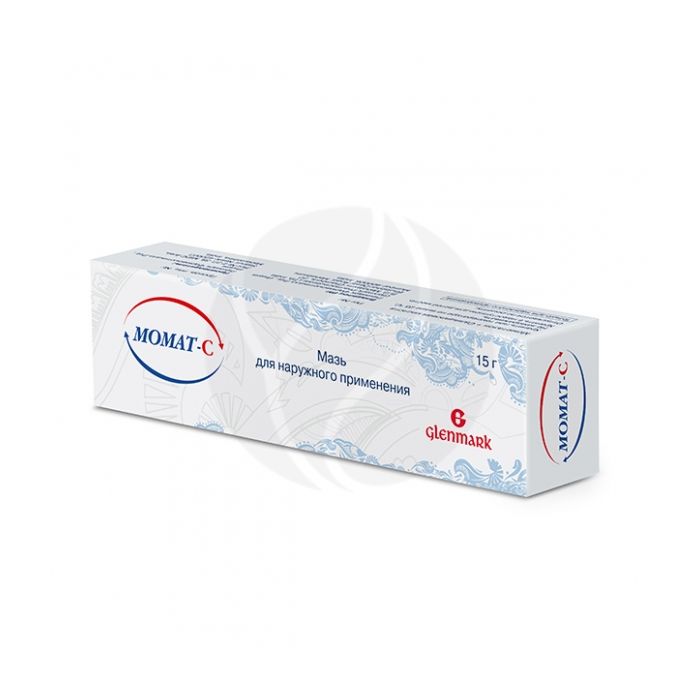Momat-S ointment for external use, 10g
Russian Pharmacy name:
Момат-С мазь для наружного применения , 10г
To relieve inflammation and hyperkeratosis:
with psoriasis;
with atopic dermatitis;
with seborrheic dermatitis.
The method of application and dosage regimen of a particular drug depends on its form of release and other factors. The optimal dosage regimen is determined by the doctor. It is necessary to strictly observe the compliance of the used dosage form of a particular drug with the indications for use and the dosage regimen.
Outwardly. A thin layer of Momat-S ointment should be applied to the affected skin areas twice a day, morning and evening; the maximum daily dose is 15 g.
The duration of the course of treatment is determined by the attending physician.
Active ingredients:
mometasone furoate - 1 mg
salicylic acid - 50 mg
Excipients : petroleum jelly (white petrolatum), white beeswax, propylene glycol monostearate, hexylene glycol.
Children's age (up to 12 years old);
hypersensitivity to mometasone furoate or salicylic acid;
bacterial, viral (herpes simplex, chickenpox, shingles) or fungal skin infections,
rosacea or perioral dermatitis,
post-vaccination reactions,
tuberculosis,
syphilis.
Carefully
Diabetes mellitus, inflammation of peripheral vessels, irritation or infection of the skin, as well as during pregnancy and lactation.
Clinical and pharmacological group: Drug with anti-inflammatory and keratolytic action for external use
Pharmaco-therapeutic group: Topical glucocorticosteroid + keratolytic agent
pharmachologic effect
Anti-inflammatory and keratolytic combination drug.
Mometasone furoate is a glucocorticosteroid. It has anti-inflammatory, antipruritic and vasoconstrictor properties. In vitro experiments have shown that mometasone furoate is a potent inhibitor of the synthesis of three cytokines involved in the development of the inflammatory process and its maintenance: interleukin-1 (IL-1), interleukin-6 (IL-6) and tumor necrosis factor alpha. (TNF-?).
Salicylic acid causes exfoliation of the stratum corneum.
Pharmacokinetics
After a single topical application, approximately 1.5% of the applied dose is subjected to systemic absorption. The drug that enters the systemic circulation is excreted in the urine and feces.
Indications
To relieve inflammation and hyperkeratosis:
with psoriasis;
with atopic dermatitis;
with seborrheic dermatitis.
Dosage regimen
The method of application and dosage regimen of a particular drug depends on its form of release and other factors. The optimal dosage regimen is determined by the doctor. It is necessary to strictly observe the compliance of the used dosage form of a particular drug with the indications for use and the dosage regimen.
Outwardly. A thin layer of Momat-S ointment should be applied to the affected skin areas twice a day, morning and evening; the maximum daily dose is 15 g.
The duration of the course of treatment is determined by the attending physician.
Side effect
Local reactions: mild to moderate burning sensation at the site of application, itching, skin atrophy, peeling, irritation, skin maceration, dry skin, folliculitis, acne, hypopigmentation, perioral dermatitis, allergic contact dermatitis, appearance of atrophic skin stripes, prickly heat, secondary infections, hypertrichosis.
Systemic reactions: in children, it is possible to suppress the function of the hypothalamic-pituitary-adrenal system, including with the development of Cushing's syndrome.
Contraindications for use
Children's age (up to 12 years old);
hypersensitivity to mometasone furoate or salicylic acid;
bacterial, viral (herpes simplex, chickenpox, shingles) or fungal skin infections,
rosacea or perioral dermatitis,
post-vaccination reactions,
tuberculosis,
syphilis.
Carefully
Diabetes mellitus, inflammation of peripheral vessels, irritation or infection of the skin, as well as during pregnancy and lactation.
Application during pregnancy and lactation
It is used during pregnancy and during breastfeeding only when the expected benefit to the mother outweighs the potential risk to the fetus.
Application in children
Contraindicated in children under 12 years of age.
special instructions
Use strictly as directed by your doctor to avoid complications. Appropriate precautions should be taken in case of application to large areas of skin or intended prolonged use of the drug. This is especially important in pediatrics. Due to the fact that the ratio of skin surface and body weight in children is higher than in adults, children are more prone than adults to suppression of the hypothalamic-pituitary-adrenal system and the development of Cushing's syndrome in response to glucocorticosteroid therapy.
Children should receive the minimum amount of glucocorticosteroids necessary to achieve the effect. Long-term therapy with glucocorticosteroids can have undesirable effects on the growth and development of children.
Glucocorticosteroids can change the appearance of the affected skin, making it difficult to make a correct diagnosis.
Not suitable for use in ophthalmology.
In case of irritation, including excessive dryness of the skin, discontinue use and prescribe appropriate treatment.
If a concomitant skin infection develops, an appropriate antifungal or antibacterial agent should be used. If a positive response to treatment is not achieved quickly, use should be discontinued until the infection is properly cleared.
Not recommended for use with occlusive dressings, including diapers and plastic panties.
Do not apply to face or groin or armpits.
Drug interactions
When applied topically, the presence of small amounts of salicylates in the blood plasma was noted.
According to data on the interaction of salicylates with other substances after ingestion or application to the skin, it is possible to change the action of the following medicinal compounds: tolbutamide (butamide), methotrexate, heparin, pyrazinamide, drugs that promote the excretion of uric acid, and drugs such as coumarin .
Other glucocorticosteroids and ammonium sulfate can affect salicylic acid levels.

